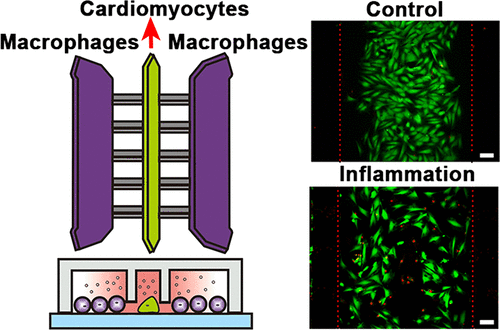当前位置:
X-MOL 学术
›
Anal. Chem.
›
论文详情
Our official English website, www.x-mol.net, welcomes your
feedback! (Note: you will need to create a separate account there.)
Microfluidic Coculture Device for Monitoring of Inflammation-Induced Myocardial Injury Dynamics
Analytical Chemistry ( IF 6.7 ) Pub Date : 2018-03-13 00:00:00 , DOI: 10.1021/acs.analchem.7b04833 Xiaoni Ai 1 , Wenbo Lu 1 , Kewu Zeng 1 , Chun Li 2 , Yong Jiang 1 , Pengfei Tu 1
Analytical Chemistry ( IF 6.7 ) Pub Date : 2018-03-13 00:00:00 , DOI: 10.1021/acs.analchem.7b04833 Xiaoni Ai 1 , Wenbo Lu 1 , Kewu Zeng 1 , Chun Li 2 , Yong Jiang 1 , Pengfei Tu 1
Affiliation

|
Emerging awareness of cardiac macrophages’ role in inflammation after myocardial infarction indicates that overabundant proinflammatory macrophages induce accentuated myocardial injury. The investigation of the macrophages–cardiomyocytes interaction and inflammation-induced dynamic damage in myocardial infarction, especially in a spatiotemporally controlled manner, remains a huge challenge. Here, we developed an in vitro model using a microfluidic coculture system to mimic inflammatory cardiac injury. To our knowledge, on-chip pathological models focused on inflammation-induced myocardial injury have not been reported. The device consists of two sets of thin interconnecting grooves that isolate heterogeneous cells spatially but maintain their soluble factors communication. The mass transportation is visually characterized, and the complete diffusion reaches equilibrium within 100 s. We investigate the dynamic interaction between the macrophages and the cardiomyocytes in the spatiotemporal controlled microenvironment, mimicking a key aspect of the in vivo pathophysiological process. The results show that the activated macrophages induce time-lapsed apoptotic responses of the cardiac cells and damage mitochondria membrane integrity. The anti-inflammatory and cardio-protective effects of quercetin were explored on the chip. The extent of caspase-3 activation is asynchronous in the individual cardiac cells, suggesting the different apoptosis dynamics. We further demonstrate that the mechanism of activated inflammation is associated with the upregulation of several inflammatory cytokines and NF-κB pathway. Thus, the developed microfluidic coculture device provides a useful tool for real-time monitoring of inflammatory response for myocardial disease and holds potential for anti-inflammatory drug screening.
中文翻译:

微流控共培养装置,用于监测炎症诱导的心肌损伤动态
心肌巨噬细胞在心肌梗死后在炎症中的作用的新兴意识表明,过量的促炎巨噬细胞会诱发严重的心肌损伤。心肌梗死中巨噬细胞-心肌细胞相互作用和炎症引起的动态损伤的研究,尤其是以时空控制的方式,仍然是一个巨大的挑战。在这里,我们开发了一种体外模型,使用微流体共培养系统来模拟炎症性心脏损伤。据我们所知,针对炎症诱导的心肌损伤的芯片病理模型尚未见报道。该设备由两组薄的互连凹槽组成,这些凹槽在空间上隔离异质细胞,但保持其可溶性因子的连通。大众运输具有视觉特征,完全扩散在100 s内达到平衡。我们调查时空控制的微环境中的巨噬细胞和心肌细胞之间的动态相互作用,模仿体内病理生理过程的一个关键方面。结果表明,活化的巨噬细胞诱导了心肌细胞的延时凋亡反应并破坏了线粒体膜的完整性。在芯片上研究了槲皮素的抗炎和心脏保护作用。caspase-3激活的程度在单个心脏细胞中是异步的,表明不同的凋亡动力学。我们进一步证明,激活炎症的机制与几种炎症细胞因子和NF-κB通路的上调有关。因此,
更新日期:2018-03-13
中文翻译:

微流控共培养装置,用于监测炎症诱导的心肌损伤动态
心肌巨噬细胞在心肌梗死后在炎症中的作用的新兴意识表明,过量的促炎巨噬细胞会诱发严重的心肌损伤。心肌梗死中巨噬细胞-心肌细胞相互作用和炎症引起的动态损伤的研究,尤其是以时空控制的方式,仍然是一个巨大的挑战。在这里,我们开发了一种体外模型,使用微流体共培养系统来模拟炎症性心脏损伤。据我们所知,针对炎症诱导的心肌损伤的芯片病理模型尚未见报道。该设备由两组薄的互连凹槽组成,这些凹槽在空间上隔离异质细胞,但保持其可溶性因子的连通。大众运输具有视觉特征,完全扩散在100 s内达到平衡。我们调查时空控制的微环境中的巨噬细胞和心肌细胞之间的动态相互作用,模仿体内病理生理过程的一个关键方面。结果表明,活化的巨噬细胞诱导了心肌细胞的延时凋亡反应并破坏了线粒体膜的完整性。在芯片上研究了槲皮素的抗炎和心脏保护作用。caspase-3激活的程度在单个心脏细胞中是异步的,表明不同的凋亡动力学。我们进一步证明,激活炎症的机制与几种炎症细胞因子和NF-κB通路的上调有关。因此,











































 京公网安备 11010802027423号
京公网安备 11010802027423号